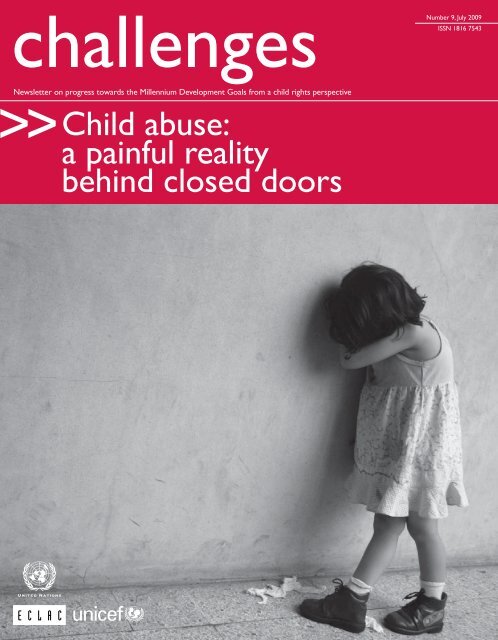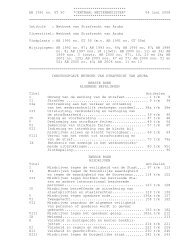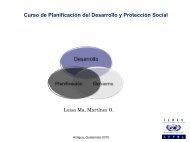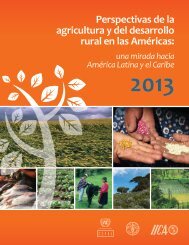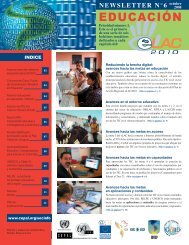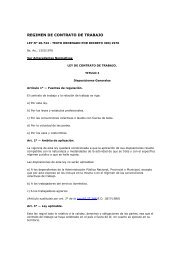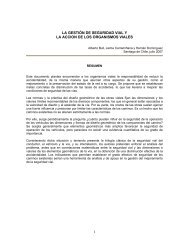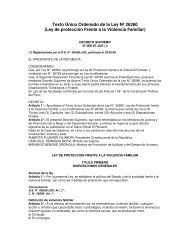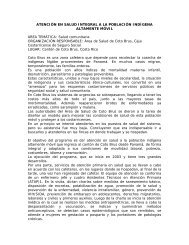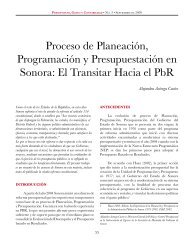Child abuse: a painful reality behind closed doors - Cepal
Child abuse: a painful reality behind closed doors - Cepal
Child abuse: a painful reality behind closed doors - Cepal
Create successful ePaper yourself
Turn your PDF publications into a flip-book with our unique Google optimized e-Paper software.
challenges<br />
>><br />
Newsletter on progress towards the Millennium Development Goals from a child rights perspective<br />
<strong>Child</strong> <strong>abuse</strong>:<br />
a <strong>painful</strong> <strong>reality</strong><br />
<strong>behind</strong> <strong>closed</strong> <strong>doors</strong><br />
Number 9, July 2009<br />
ISSN 1816 7543<br />
1
editorial<br />
> The harsh <strong>reality</strong><br />
of child <strong>abuse</strong><br />
<strong>Child</strong> <strong>abuse</strong> violates the most basic rights of<br />
children and adolescents. As documented in<br />
the main article of this issue of Challenges, child<br />
<strong>abuse</strong> is a massive, daily and underreported<br />
problem that affects the population<br />
of Latin America and the Caribbean. It<br />
manifests itself in different forms, including<br />
physical and psychological aggression, rape<br />
and sexual <strong>abuse</strong>, and takes place in the home,<br />
in neighbourhoods, at school, at work and in<br />
legal and child protection institutions. Abuse<br />
tends to be transmitted from one generation<br />
to the next, and the individuals most often<br />
responsible are parents or other adult<br />
members of the household.<br />
Despite the difficulty in comparing the<br />
information available from different countries<br />
due to disparate samples and methodologies,<br />
in the 16 countries studied for this article<br />
the percentage of those interviewed who<br />
acknowledge personal or family <strong>abuse</strong> is<br />
quite high (ranging from 33% and 83%).<br />
Reported cases are only a partial indication<br />
of the scale of <strong>abuse</strong>, however, since many<br />
cases go unreported for fear of reprisals, lack<br />
of information on how to file a complaint, or<br />
because many simply assume that physical<br />
and verbal punishment are a natural part of<br />
discipline and socialization.<br />
In the testimonials column, four children<br />
explain what violence means to them;<br />
in viewpoints, a world renowned Colombian<br />
expert on child <strong>abuse</strong> shares her perspective; the<br />
learning from experience section highlights<br />
a Peruvian programme that identifies and<br />
prevents child <strong>abuse</strong> in the health sector;<br />
and, finally, there is a brief account of recent<br />
events and key documents on the theme.<br />
2<br />
THE EDITORIAL COMMITTEE<br />
>><br />
© Unicef Panama, 2005, Mike Gelder<br />
summary<br />
02<br />
03<br />
editorial<br />
The harsh <strong>reality</strong><br />
of child <strong>abuse</strong><br />
agenda<br />
Recent events<br />
Key documents<br />
the voice of children<br />
and adolescents<br />
Living with violence:<br />
children’s<br />
perspectives<br />
04<br />
analysis<br />
and research<br />
<strong>Child</strong> <strong>abuse</strong>:<br />
a <strong>painful</strong> <strong>reality</strong><br />
<strong>behind</strong> <strong>closed</strong> <strong>doors</strong><br />
10 view points<br />
Isabel Cuadros Ferré:<br />
The scope of child<br />
<strong>abuse</strong> in Latin America<br />
11<br />
learning from<br />
experience<br />
<strong>Child</strong> Abuse Care Units<br />
(MAMIs) in Peru<br />
12 ¿did you know...?<br />
Economic Commission for Latin America and the Caribbean (ECLAC)<br />
United Nations <strong>Child</strong>ren’s Fund (UNICEF),<br />
Regional Office for Latin America and the Caribbean (UNICEF TACRO)<br />
Editorial Committee:<br />
ECLAC: Martín Hopenhayn +<br />
María Nieves Rico + Jorge Rodríguez<br />
UNICEF: Enrique Delamónica + Egidio Crotti<br />
+ Susana Sottoli<br />
General coordination:<br />
María Nieves Rico + María S. Spence<br />
Contributors:<br />
(UNICEF) Soledad Mac-Pherson +<br />
Francisca Palma + Rosana Vega + Violet Warnery<br />
Design and layout:<br />
Paulo Saavedra + Rodrigo Saavedra<br />
Challenges<br />
Number 9, July 2009<br />
ISSN printed edition 1816-7543<br />
ISSN electronic edition 1816-7551<br />
Cover photo<br />
© UNICEF-NYHQ, 2006, Kate Brooks<br />
© United Nations, July 2009.<br />
All rights reserved<br />
Contact:<br />
desafios@cepal.org,<br />
desafios@unicef.org<br />
© Unicef Panama, 2006, Cèsar Villar<br />
challenges
agenda<br />
Recent events<br />
>> Marta Santos Pais, named United Nations Special Representative<br />
on Violence against <strong>Child</strong>ren.<br />
United Nations Secretary-General Ban Ki-moon appointed Marta<br />
Santos Pais as Special Representative for a period of three years. The<br />
post was created in response to one of the recommendations<br />
contained in the World Report on Violence against <strong>Child</strong>ren, drafted<br />
in 2006 at the request of the Secretary-General. As of May 1, the<br />
Portuguese attorney with more than 25 years experience in human<br />
rights will be a global advocate for children’s rights, promoting the<br />
prevention and elimination of all forms of violence against children.<br />
http://www.un.org/News/Press/docs/2009/sga1182.doc.htm<br />
>>III Pan American and XVII Colombian congress on prevention and<br />
response to child <strong>abuse</strong>: “<strong>Child</strong> protection communities”<br />
Aimed at professionals and personnel working with children in the<br />
health, justice, protection and education sectors in the<br />
countries of the Americas, the congress is organized by the association<br />
against child <strong>abuse</strong> in Colombia (AFECTO) and<br />
was held in Bogota from 23-25 September 2009.<br />
http://www.afecto.org.co/<br />
>> Annual “peace for prosperity” campaign in Jamaica<br />
An initiative of the Violence Prevention Alliance, the campaign was<br />
carried out from January to April 2009. During this period, numerous<br />
activities were conducted in the cities of Kingston, Clarendon and<br />
St. James to raise citizen awareness on the importance of building<br />
protective environments for children and adolescents.<br />
http://www.vpajamaica.com/index/<br />
Key documents<br />
>> University of Huddersfield, 2009<br />
Jones, Adele (coord.), Centre for Applied <strong>Child</strong>hood<br />
Studies and Action for <strong>Child</strong>ren. Devastated <strong>Child</strong>hoods:<br />
Perceptions of Attitudes to and Opinions on <strong>Child</strong> Sexual<br />
Abuse in the Eastern Caribbean. Executive summary,<br />
findings and interim report.<br />
http://www2.hud.ac.uk/news/2009news/05_eastern_<br />
caribbean_project/contents_page.php<br />
>> UNICEF, 2007<br />
State of the World’s <strong>Child</strong>ren 2008: <strong>Child</strong> Survival<br />
http://www.unicef.org/publications/files/SOLAC_2008_<br />
EN_041408.pdf<br />
>> United Nations, 2006<br />
Pinheiro, Paulo Sergio (2006), World Report on Violence<br />
against <strong>Child</strong>ren, United Nations Secretary-General’s<br />
Report on Violence against <strong>Child</strong>ren, New York. A United<br />
Nations publication.<br />
http://www.unviolencestudy.org/<br />
the voice of children and adolescents<br />
Living with<br />
violence:<br />
children’s<br />
perspectives<br />
Four Latin American children tell what<br />
violence means to them<br />
• “Violence is <strong>abuse</strong>, punishment, violence at home, not taking<br />
care of girls, forced labour, killing, fighting, threats and<br />
discrimination for being a girl.”<br />
(Costa Rican girl)<br />
• “Violence can be physical <strong>abuse</strong>; like when they burn my head.<br />
Sometimes just by saying that I’m useless they are abusing me<br />
psychologically.”<br />
(Adolescent girl)<br />
• “It’s partly our fault for not obeying our parents. They want to<br />
help us by punishing us.”<br />
(Adolescent boy)<br />
• “The kind of violence that can occur against an adolescent inside<br />
the family is physical and sexual violence, which is the most<br />
common and is committed by parents. They <strong>abuse</strong> their<br />
daughters and sometimes don’t realize how much harm it can<br />
cause them.”<br />
(Adolescent girl)<br />
Source: United Nations <strong>Child</strong>ren’s Fund (UNICEF), La violencia contra niños, niñas<br />
y adolescentes. Informe de América Latina en el marco del Estudio mundial de las<br />
Naciones Unidas, Regional Office for Latin America and the Caribbean, 2006.<br />
© Unicef Chile, 2005, Anthony Asael<br />
3
4<br />
analysis and research<br />
<strong>Child</strong> <strong>abuse</strong>:<br />
A <strong>painful</strong> <strong>reality</strong><br />
<strong>behind</strong> <strong>closed</strong> <strong>doors</strong><br />
Soledad Larraín and Carolina Bascuñán,<br />
consultants, UNICEF Chile<br />
Introduction<br />
<strong>Child</strong> <strong>abuse</strong> constitutes a violation of the most basic rights<br />
of children and adolescents, which are enshrined in the<br />
Universal Declaration of Human Rights. All persons under<br />
the age of 18 have the right to physical and psychological<br />
integrity, and to protection from all forms of violence.<br />
Article 19 of the Convention on the Rights of the <strong>Child</strong> (CRC)<br />
–adopted by the United Nations in 1989– exhorts States<br />
parties to take “all appropriate legislative, administrative,<br />
social and educational measures to protect the child from<br />
all forms of physical or mental violence, injury or <strong>abuse</strong>,<br />
neglect or negligent treatment, maltreatment or exploitation,<br />
including sexual <strong>abuse</strong>, while in the care of parent(s), legal<br />
guardian(s) or any other person who has the care of the<br />
child”. Similarly, the United Nations International Committee<br />
on the Rights of the <strong>Child</strong> has emphasized the importance<br />
of member countries prohibiting all forms of physical<br />
punishment and degrading treatment of children (CRC, 2006).<br />
Nonetheless, we know that for various social and cultural<br />
reasons, children and adolescents suffer violence in the home,<br />
at school, in legal and child protection systems, at work and<br />
in the community. Thus, children and adolescents are <strong>abuse</strong>d<br />
precisely in those spaces and places that should offer them<br />
protection, affection, developmental stimulation, shelter and<br />
promotion for their rights. One of the factors that makes<br />
them highly vulnerable is their lack of autonomy due to<br />
their young age and the consequent high levels of emotional,<br />
economic and social dependency on adults or institutions<br />
(Pinheiro, 2006), which make it difficult for them to put a<br />
stop to the <strong>abuse</strong>, request help or report the situation.<br />
V<br />
Violence is understood to be “the intentional use of<br />
force or physical power, either by act or threat, against<br />
oneself, another person or a group or community, which<br />
causes or has substantial likelihood of causing injuries,<br />
death, psychological harm, developmental disruptions,<br />
disturbances or deprivations” (WHO, 2002). In the same<br />
sense, child <strong>abuse</strong> is defined as “acts or omissions carried<br />
out with intent to cause immediate harm to the victim. The<br />
<strong>abuse</strong>r perceives the harm caused as the ultimate goal of<br />
their actions. A syndrome is created in surviving victims,<br />
known as battered-child syndrome. There are three main<br />
types of child <strong>abuse</strong>: physical, emotional/psychological and<br />
neglect/abandonment. These forms of <strong>abuse</strong> lead to lasting<br />
physical and emotional injuries, death or other serious<br />
harm” (Latin American Regional Office of the Report on<br />
Violence against <strong>Child</strong>ren and Adolescents, 2006).<br />
The manifestations of violence suffered by children are<br />
diverse. They range from physical punishment to other forms<br />
of cruel and degrading treatment at the hands of their parents<br />
or other family members, or by persons responsible for their<br />
care in child protection facilities, schools or the workplace.<br />
Even at the social level, children identified as “a danger or<br />
challenges
threat to society” may be <strong>abuse</strong>d by the police. <strong>Child</strong>ren<br />
and adolescents, especially girls, may also be subjected to<br />
psychological violence and sexual <strong>abuse</strong> in the different<br />
environments where they grow up (Pinheiro, 2006).<br />
Evidence suggests that only a small part of the violence<br />
perpetrated against children is reported to the legal system<br />
and investigated by the authorities, and few offenders are<br />
brought to trial. Furthermore, while in many places in the<br />
world there are no reliable systems for filing complaints,<br />
there are estimates that every year 275 million children around<br />
the world are the victims of violence in their households, and<br />
some 40 million persons under 15 suffer violence, <strong>abuse</strong> and<br />
neglect. These incidents are reportedly take place in different<br />
contexts: in families, in schools, in the community, on the<br />
street and in work situations (UNICEF, 2007a).<br />
The family and the household are socially and legally<br />
conceived as spaces for protection and safety for children<br />
and adolescents. In this regard, the CRC considers the<br />
natural environment for child development to be the family,<br />
while still recognizing that this can be a dangerous space.<br />
While violence “<strong>behind</strong> <strong>closed</strong> <strong>doors</strong>” has been difficult to<br />
detect and measure, perhaps the most complex aspect is<br />
accepting that those who are expected to protect children<br />
© Unicef Panama, 2005, Mike Gelder<br />
–generally the parents– are precisely the ones who strike,<br />
assault, threaten, punish or <strong>abuse</strong> them.<br />
Until now, and despite the efforts that have been<br />
made, the countries in this region have not developed an<br />
effective response to child <strong>abuse</strong>. One of the main difficulties in<br />
developing such a response lies in the lack of information on<br />
the true scope and characteristics of <strong>abuse</strong>, especially when it<br />
takes place in the home and in the family context.<br />
S<br />
The scope of child <strong>abuse</strong><br />
At the international level, the 2003 World Health<br />
Organization (WHO) publication on violence as a public<br />
health problem throughout the world, and the preparation<br />
in 2006 of the United Nations Study on Violence against<br />
<strong>Child</strong>ren 1 with its in-depth investigation of the phenomenon<br />
of child <strong>abuse</strong>, are great contributions towards assessing<br />
this issue at the global level, and help to evaluate progress,<br />
share good practices and highlight pending challenges.<br />
Studies show that in addition to being one of the most<br />
unequal regions of the world, Latin America and the<br />
Caribbean –with a population of more than 190 million<br />
children– has the highest rate of violence affecting women<br />
and children (Pinheiro, 2006). According to the Secretary-<br />
General’s study, in this region violence against children<br />
and adolescents in the family is manifested mainly through<br />
physical punishment –as a form of discipline– sexual <strong>abuse</strong>,<br />
neglect and economic exploitation.<br />
Notwithstanding the above-mentioned limitations, one<br />
of the main sources of information for learning about<br />
and analyzing the scope of physical <strong>abuse</strong> in the region’s<br />
countries is the compilation of official statistics on complaints<br />
registered with social services, police stations, hospitals and<br />
children’s services. These complaints, however, only provide<br />
a partial picture of the <strong>reality</strong> of <strong>abuse</strong>, and it is believed that<br />
the available data show only the tip of the iceberg in terms<br />
of real problem of intra-family violence. This demonstrates<br />
that the phenomenon is more widespread than it appears and<br />
cannot be adequately measured using only this method.<br />
Since records have been available, it has been observed in<br />
all the countries that reports of physical and sexual <strong>abuse</strong><br />
of children made by different institutions in sectors like<br />
health and education, or by family members themselves, are<br />
increasing every year. This does not necessarily mean an<br />
increase in cases; rather, it likely reflects an increase in social<br />
awareness of the problem, the promulgation of laws for the<br />
protection of children and punishment of violence, and the<br />
implementation of more accessible and efficient mechanisms<br />
for handling complaints.<br />
A cursory analysis of the records of complaints leads to<br />
the conclusion that, in most cases, the <strong>abuse</strong>rs are known to<br />
the victims, and in large proportion are family members; and<br />
that physical <strong>abuse</strong> is inversely proportional to the age of the<br />
child, while sexual <strong>abuse</strong> generally occurs when the victims,<br />
1 Professor Paulo Sérgio Pinheiro performed the study at the request of the Secretary-General of the United Nations, in collaboration with the Office of the United Nations High Commissioner<br />
for Human Rights (OHCHR), the United Nations <strong>Child</strong>ren’s Fund (UNICEF) and the World Health Organization (WHO).<br />
5
6<br />
analysis and research<br />
TABLE I<br />
SOUTH AMERICA: STUDIES OF THE PREVALENCE OF CHILD ABUSE IN SELECTED COUNTRIES<br />
Country Latest year measured Sample Methodology Main fi ndings<br />
Argentina a/ Argentina 2000-2001 450 university Retrospective Study 55% of those surveyed<br />
students admitted to having received<br />
physical punishment in childhood<br />
a/<br />
2000-2001 450 university Retrospective Study 55% of those surveyed<br />
students admitted to having received<br />
physical punishment in childhood<br />
Bolivia (Plur. 2007 20 000 households National Demographic and Health In 83% of the households,<br />
State of) b/ throughout the country Survey (ENDSA) 2003c/ children are punished<br />
by an adult<br />
Chile d/ Chile 2006 1 525 children Self-administered questionnaire 75.3% of the children interviewed<br />
between 12 and 17 answered by children in the sample had experienced some kind of<br />
violence by their parents<br />
(physical and psychological)<br />
d/<br />
2006 1 525 children Self-administered questionnaire 75.3% of the children interviewed<br />
between 12 and 17 answered by children in the sample had experienced some kind of<br />
violence by their parents<br />
(physical and psychological)<br />
Colombia e/ 2005 Probabilistic, comprising National Demographic 42% of the women reported<br />
37 000 households and Health Survey (ENDS) 2005 that their husbands or companions<br />
punished their children by<br />
hitting them<br />
Ecuador f/ Ecuador 2005 No information The 2004 National Household 51% of the children reported<br />
Survey questioned children 6 to 11 having been victims of <strong>abuse</strong><br />
f/<br />
2005 No information The 2004 National Household 51% of the children reported<br />
Survey questioned children 6 to 11 having been victims of <strong>abuse</strong><br />
Peru g/ 2000 27 259 mothers ages Survey requested by the 41% of all parents result to<br />
15 to 49 and their children Ministry of Health. spanking to discipline<br />
under 5 years of age mothers and their children were their children<br />
interviewed on the use of<br />
physical punishment<br />
Uruguay h/ Uruguay 2008 Multi-phase household Measures the use of physical and 82% of the adults interviewed<br />
survey of 1 100 cases psychological punishment report some form of psychological<br />
in the home or physical violence toward a<br />
child in their household<br />
h/<br />
2008 Multi-phase household Measures the use of physical and 82% of the adults interviewed<br />
survey of 1 100 cases psychological punishment report some form of psychological<br />
in the home or physical violence toward a<br />
child in their household<br />
Source: prepared by the authors on the basis of<br />
a/ Eva Giberti (comp.), Abuso sexual y malos tratos contra niños, niñas y adolescentes: perspectiva psicológica y social, Buenos Aires, Espacio Editorial, 2005;<br />
b/ Economic and Social Policy Analysis Unit (UDAPE)/United Nations <strong>Child</strong>ren’s Fund (UNICEF), Bolivia: determinantes de la violencia contra la niñez y adolescencia, La Paz, 2008;<br />
c/ United Nations <strong>Child</strong>ren’s Fund(UNICEF), Maltrato infantil y relaciones familiares en Chile: análisis comparativo 1994-2000-2006, Santiago, Chile, 2008;<br />
d/ Profamilia, Encuesta Nacional de Demografía y Salud 2005 (ENDS 2005), Bogotá;<br />
e/ Observatory for the Rights of <strong>Child</strong>ren and Adolescents (ODNA), Estado de los derechos de la niñez y la adolescencia en el Ecuador 2005 (EDNA 2005), Quito, 2006;<br />
f/ National Institute of Statistics and Informatics (INEI), Encuesta Demográfi ca y de Salud Familiar, 2000 (ENDES 2000), Lima, 2001;<br />
g/ Ministry of Social Development/ InfamiliaProgramme, Estudio prácticas de crianza y resolución de confl ictos familiares, Montevideo, 2008.<br />
mainly girls, are between 7 and 11 years of age. This latter<br />
form of child <strong>abuse</strong> is the one least reported, especially when<br />
committed by parents or close family members.<br />
Another important source of information in Latin<br />
America and the Caribbean are the studies designed to detect<br />
child <strong>abuse</strong> in the population, which have been conducted<br />
since the 1990s.<br />
Population studies<br />
Studies on child <strong>abuse</strong> conducted in the region have been<br />
designed with the important purpose of providing data<br />
to adequately refl ect the situation. However, as evidenced<br />
in the following tables, the lack of harmonization of<br />
methodologies used to measure the different kinds of<br />
<strong>abuse</strong> and the differences among the samples has meant<br />
that data is not comparable between the countries. In some<br />
cases children are asked specifi cally about the child-rearing<br />
practices used by their parents (Chile); in others, in addition to<br />
questioning the children, the parents also are consulted about<br />
child-rearing styles (Uruguay). In other countries, like<br />
Argentina, the studies are retrospective and ask adult persons<br />
whether they suffered violence as children at the hands of their<br />
parents, and in the case of the Plurinational State of<br />
Bolivia, for example, the consultation focuses on whether<br />
the person interviewed person knows anyone who suffers<br />
violence at home.<br />
The vast majority of the studies focus on physical violence,<br />
but some of the countries of South America also incorporate<br />
psychological violence, and in the Caribbean countries there<br />
has been special interest in measuring sexual violence, which<br />
is closely linked to gender violence. Girls have a much greater<br />
risk of becoming victims of sexual <strong>abuse</strong> by family members<br />
or strangers. Studies in the region show that for every boy<br />
that is sexually <strong>abuse</strong>d, three or four girls are victims of the<br />
same crime.<br />
In South America, the family is clearly a place where a large<br />
percentage of the situations of violence against children and<br />
adolescents occur. In most of the countries, approximately<br />
challenges
TABLE II<br />
MEXICO AND SELECTED CENTRAL AMERICAN COUNTRIES: STUDIES OF THE PREVALENCE OF CHILD ABUSE<br />
Country Latest year Sample Methodology Main fi ndings<br />
of measurement<br />
Costa Rica a/ Costa Rica 2003 Representative sample of Telephone survey 74.2% of those surveyed<br />
of the population 18 years verbally <strong>abuse</strong> their children.<br />
of age and older (600 cases) 65.3% use physical violence<br />
a/<br />
2003 Representative sample of Telephone survey 74.2% of those surveyed<br />
of the population 18 years verbally <strong>abuse</strong> their children.<br />
of age and older (600 cases) 65.3% use physical violence<br />
Mexico b/ 2000 4 000 000 children and Directly administered One-third of the children<br />
adolescents between questionnaire between 6 and 9 said they<br />
6 and 17 years of age are treated with violence,<br />
both in the family and<br />
at school<br />
Nicaragua c/ Nicaragua 2004 No information Study of the database of 68% of all sexual <strong>abuse</strong><br />
complaints performed by<br />
the Centre for Research in<br />
Demography and Health (CIDS)<br />
of the School of Medical<br />
Sciences, UNAN-León<br />
occurs in the home<br />
c/<br />
2004 No information Study of the database of 68% of all sexual <strong>abuse</strong><br />
complaints performed by<br />
the Centre for Research in<br />
Demography and Health (CIDS)<br />
of the School of Medical<br />
Sciences, UNAN-León<br />
occurs in the home<br />
Source: prepared by the authors on the basis of<br />
a/ Institute for Social Studies on Population (IDESPO), Percepciones de la ciudadanía costarricense sobre la niñez, Heredia, August-September 2004;<br />
b/ Federal Electoral Institute (IFE), Consulta infantil y juvenil 2000, Mexico City, 2000;<br />
c/ Save the <strong>Child</strong>ren Noruega- Programa en Nicaragua, Informe sobre abuso sexual de niñas, niños y adolescentes: Nicaragua 2005, Managua, 2006.(c) Save the <strong>Child</strong>ren Noruega- Programa en<br />
Nicaragua, Informe sobre abuso sexual de niñas, niños y adolescentes: Nicaragua 2005, Managua, 2006.<br />
50% of all children and adolescents suffer some kind of<br />
violence. Physical violence, considered less serious, is also<br />
the most frequent kind and consists of slapping, pinching,<br />
and blows to the arms, legs and head. More serious<br />
violence is less common, and consists of blows with objects,<br />
whippings, threats and even in some cases, use of weapons.<br />
Finally, psychological <strong>abuse</strong> is also habitual, in the form of<br />
insults, teasing, discrediting, isolation and even expulsion<br />
from the home, and generally is not considered violence as<br />
such, since –like the less serious violence– it is justifi ed as a<br />
form of discipline.<br />
While child <strong>abuse</strong> is found in all social strata, in terms<br />
of characterizing parents, in some countries like Peru the<br />
highest levels of punishment occur among mothers in the<br />
lowest socio-economic strata, with the least education.<br />
In Chile, serious physical violence is greater in lowerincome<br />
strata, but psychological violence in greater at the<br />
higher-income levels. In Mexico and Central America,<br />
physical punishment is justifi ed as a mechanism used<br />
by parents to correct or “straighten out” their children’s<br />
behaviour, so forms of violence like beating, pinching or<br />
kicking children are not considered to be harmful (Costa<br />
Rica). In terms of sexual <strong>abuse</strong>, the perpetrators are mostly<br />
men between 18 and 30 years of age. Research from the<br />
Nicaragua study suggests that in 90% of all cases the<br />
most frequent perpetrators of <strong>abuse</strong> against adolescents are<br />
fathers, step-fathers, brothers or boyfriends. Only 10% of<br />
perpetrators were strangers. 2<br />
eceived punishment for disobeying their parents’ authority.<br />
As is the case with studies on reporting, these studies confirm<br />
that children suffer more violence when they are youngest.<br />
In some countries, <strong>abuse</strong> is more prevalent for children 4 to 6<br />
years old (Argentina, the Plurinational State of Bolivia, Chile<br />
and Uruguay).<br />
In all the countries, violence and <strong>abuse</strong> suffered by the<br />
father and mother when they were children is the most<br />
relevant risk factor for violence against the children in their<br />
families, since it leads to an intergenerational transmission of<br />
violence. Furthermore, child <strong>abuse</strong> in the home is closely<br />
related to –and increases with– the presence of violence<br />
against women, either when they were girls or as mothers<br />
and wives.<br />
O<br />
One of the most brutal forms of gender-based violence are<br />
the feminicides that occur every year in the region. <strong>Child</strong>ren<br />
are the indirect victims, often being orphaned by the suicide<br />
of a feminicidal father, and in an increasingly alarming<br />
percentage of cases, they become the direct victims of<br />
the misogynist violence of their fathers. The fate of<br />
these children and adolescents after such an act takes place<br />
becomes uncertain if they cannot find someone to assume<br />
responsibility for their protection. Many of them are left<br />
with other family members or elderly grandparents already<br />
living in precarious subsistence conditions, 3 or else in child<br />
protection institutions, without adequate treatment for their<br />
traumatic experience.<br />
Pending challenges<br />
The information presented here confirms that violence<br />
against children and adolescents is a serious human<br />
rights problem in Latin America and the Caribbean. More<br />
than half of all children in the region are victims of physical<br />
or emotional <strong>abuse</strong>, negligent treatment or sexual <strong>abuse</strong>.<br />
In response to this scourge, and based on the ratification<br />
of the Convention on the Rights of the <strong>Child</strong>, which reaffirms<br />
the condition of children as bearers of rights, there have been<br />
important advances towards addressing the problem in the<br />
region, and breaking the silence regarding this serious human<br />
rights violation in the family environment. At present there<br />
is greater awareness of the need to condemn violence against<br />
children, which has led to the implementation of concrete<br />
actions to produce the needed changes – among them new<br />
laws, victim attention programmes, improvements to the<br />
systems for filing complaints, punishment of perpetrators<br />
and studies designed to determine the scope and complexity<br />
of the violence.<br />
As affirmed in the United Nations Secretary-General’s<br />
Report, no form of violence against children is justifiable and<br />
all violence is preventable (Pinheiro, 2006).<br />
Thus, the real challenge lies in ending child <strong>abuse</strong> now, and<br />
all necessary efforts must be made to change the mentality<br />
and culture that sanction violent behaviour as a method<br />
of discipline.<br />
In order to advance toward this goal, priority must be given<br />
to prevention and early intervention, incorporating all the<br />
institutions that have contact with children and adolescents.<br />
The implementation of effective policies calls for precise<br />
and reliable data on the scope, characteristics, risk and<br />
protection factors, and the impact of violence against<br />
In Latin America and the Caribbean, 40 million children under 15 years<br />
of age suffer violence, <strong>abuse</strong> and neglect in the family, the school,<br />
the community and the street<br />
children in the family environment. This information must be<br />
comparable among the region’s different countries.<br />
Having figures that show the true scope of child <strong>abuse</strong> in the<br />
family environment will allow us to adequately formulate<br />
public policies, allocate resources and, above all, design and<br />
implement the prevention policies that are currently lacking<br />
in the region.<br />
3 In Chile, in 2008, the Chamber of Deputies asked the President of the Republic to approve a subsidy for the children of victims of feminicide (Amnesty International. November 2008).<br />
Bibliography<br />
CRC (Convention on the Rights of the <strong>Child</strong>) (2006), “General Comment, No. 8”, Committee<br />
on the Rights of the <strong>Child</strong>, Forty-Second Session (CRC/C/GC/8), Geneva, 21 August.<br />
Pinheiro, Paulo Sérgio (2006), World Report on Violence Against <strong>Child</strong>ren, Geneva, United<br />
Nations Study on Violence Against <strong>Child</strong>ren.<br />
UNICEF (United Nations <strong>Child</strong>ren’s Fund) (2008), “Protección infantil contra el abuso y la<br />
violencia” [online] http://www.unicef.org/spanish/protection/index_action.html.<br />
_____ (2007a), State of the World’s <strong>Child</strong>ren 2008: <strong>Child</strong> Survival, New York, December.<br />
10<br />
viewpoints<br />
How widespread is child <strong>abuse</strong> in Latin America?<br />
What are its main causes? What priority<br />
should governments give it?<br />
© Unicef Chile, Soledad Mac-Pherson<br />
* Contact: afecto@afecto.org.co<br />
Isabel<br />
Cuadros Ferré*<br />
Colombian psychiatrist,<br />
executive director of the association against<br />
child <strong>abuse</strong> in Colombia (AFECTO), and<br />
member of the Executive Council of the<br />
International Society for Prevention of <strong>Child</strong><br />
Abuse and Neglect (ISPCAN)<br />
The scope of child <strong>abuse</strong> in Latin America is epidemic, without<br />
regard for social class, ethnicity or gender.<br />
Information on the phenomenon of child <strong>abuse</strong> –even though it<br />
cannot be compared between one country and another– comes<br />
from two main sources: the legal and the health sectors. The<br />
two speak different languages when describing the problem<br />
of maltreatment and sexual <strong>abuse</strong> suffered by our children<br />
and adolescents.<br />
The main causes of the <strong>abuse</strong> of children have changed very little<br />
since 1962, when Dr. Henry Kempe, a paediatrician in Denver,<br />
USA, described the battered-child syndrome to the world:<br />
1. The parents have histories of psycho-affective<br />
deprivation, neglect or physical or sexual <strong>abuse</strong> as children.<br />
2. The child is perceived as not deserving love.<br />
3. There is a family crisis.<br />
4. The family is nuclear and isolated from community<br />
support systems.<br />
The most effective policies are those aimed at improving<br />
people’s living conditions, and include positive child rearing,<br />
post-partum home visits, strengthening of affective ties,<br />
education for family life, educating parents and care-givers<br />
about the stages of child development, working on peaceful<br />
conflict resolution, early detection of sexual <strong>abuse</strong> and<br />
distancing the identified <strong>abuse</strong>rs from the children.<br />
Governments should give priority to designing comprehensive<br />
public policies that allow the legal, health and protection sectors<br />
to work in conjunction, and have sufficient funding to provide<br />
for the interventions needed to improve the situation of the<br />
children and adolescents of the Americas.
challenges<br />
learning from experience<br />
<strong>Child</strong> Abuse<br />
Care Units<br />
(MAMIs) in Peru<br />
T<br />
The first intervention strategies to combat child<br />
<strong>abuse</strong> in Peru’s health service institutions came about<br />
through the <strong>Child</strong> Abuse Care Units (MAMIs, for their<br />
Spanish acronym), implemented as part of the child<br />
protection policy promoted by the Government of<br />
Peru beginning in the 1990s.<br />
In late 1994, as a result of the political will of<br />
what was then called the National Sub-Programme<br />
on Mental Health (PNSM) under the Ministry of<br />
Health (MINSA), the Technical Committee on <strong>Child</strong><br />
Abuse (CTMI) –which created the MAMIs– was borne<br />
out of a framework agreement signed by the PNSM<br />
and UNICEF.<br />
The idea <strong>behind</strong> this initiative is a novelty in<br />
care practices, using a comprehensive and<br />
multidisciplinary approach, teamwork, training,<br />
instruction and networking.<br />
The members of the MAMI teams come from different<br />
specializations such as traumatology, gynaecology,<br />
psychology, outpatient social and personal assistance,<br />
are sensitive to the issue of <strong>abuse</strong> and alert to any<br />
suspicion of violence, which immediately triggers a<br />
joint consultation.<br />
In order to implement the MAMIs in the national<br />
hospitals, participation and commitment from the<br />
health centre administrators was needed to provide a<br />
http://www.unicef.org/peru/spanish/protection_3226.htm [24 june 2009].<br />
physical space for the teams, and to officially appoint<br />
team members.<br />
At the central level, the Ministry of Health is<br />
responsible for training the unit’s personnel to perform<br />
diagnoses and timely intervention, and for<br />
implementing awareness-raising campaigns for all the<br />
personnel. To date, 32 MAMIs have been created in<br />
all of Peru and 25 of them are located in hospitals.<br />
The experience thus far has underscored the need for<br />
regulations to facilitate and standardize the operation<br />
of the units and guarantee the sustainability of the<br />
strategy. At present UNICEF, the Ministry of Health<br />
and the directors of the MAMIs are preparing draft<br />
regulations to be approved by ministerial resolution.<br />
These regulations stress the importance of keeping<br />
systematic records on cases to improve follow-up and<br />
understanding of the cases that have been referred.<br />
A significant example of the effect of the<br />
methodology being used can be found in the North<br />
Lima legal district, where child and adolescent victims<br />
of violence and sexual <strong>abuse</strong> have received<br />
multi-disciplinary treatment. The findings of the<br />
psychological evaluation of cases referred by the<br />
prosecutor’s office are received in sealed envelopes<br />
by the MAMI at the Cayetano Heredia Hospital<br />
which then initiates therapy, and seeks to avoid the<br />
revictimization of the child or adolescent.<br />
© Unicef Panama,2006, Cèsar Villar<br />
11
12<br />
did you know?<br />
…that in this region, domestic violence<br />
and accidents in the home cause approximately 50% of the<br />
deaths from external factors in children under 5.<br />
Source: UNICEF (United Nations <strong>Child</strong>ren’s Fund), The State of Latin American<br />
and Caribbean <strong>Child</strong>ren, 2008, New York, 2008.<br />
… that 28% (12,592 cases) of the attention provided by the<br />
Peruvian National Programme against Family and Sexual<br />
Violence (PNCVFS)’s women’s emergency centres<br />
corresponds to persons of both sexes under 18 years of age.<br />
Of these, 30.4% have been victims of sexual violence, and girls<br />
are at much higher risk than boys, by a factor of 9 to 1. The<br />
remaining 69.6% suffer from physical and psychological<br />
violence, evenly distributed between the sexes.<br />
Source: Statistics from the National Programme against Family and Sexual<br />
Violence, Ministry of Women and Social Development of Peru, Registry of<br />
persons attended in the women’s emergency centres 2008, Lima 2009.<br />
...that according to data from the children’s Ombudsman’s<br />
offices of La Paz, El Alto and Cochabamba, on average fewer<br />
than 1% of the cases reported to the prosecutor’s office in the<br />
Plurinational State of Bolivia are punished by the justice system.<br />
Source: United Nations <strong>Child</strong>ren’s Fund/National Institute of Statistics of<br />
Bolivia (UNICEF/INE), Violencia contra la niñez en Bolivia, La Paz, 2007<br />
….that in Uruguay, from May 2007 to December 2008, the<br />
government assisted 359 children who were victims of<br />
violence and in 85% of the cases the <strong>abuse</strong>rs were family<br />
members. In addition, 83% of adults surveyed in the<br />
Montevideo metropolitan area reported having used<br />
some kind of physical or psychological violence against a<br />
child in their home.<br />
Source: Office of the President of the Republic of Uruguay, SIPIAV (National<br />
System for the Protection of <strong>Child</strong>ren and Adolescents), 2008 Operating<br />
Report, Montevideo, 2009.<br />
1<br />
2<br />
3<br />
4<br />
5<br />
6<br />
7<br />
8<br />
<strong>Child</strong> poverty in Latin America<br />
<strong>Child</strong> malnutrition in Latin America<br />
and the Caribbean<br />
Teenage motherhood in Latin America and the<br />
Caribbean. Trends, problems and challenges<br />
Teenage motherhood in Latin America and the<br />
Caribbean. Trends, problems and challenges<br />
The right of children and adolescents to a<br />
healthy environment. A diagnosis from Latin<br />
America and the Caribbean<br />
Reduction of infant mortality in Latin America<br />
and the Caribbean: uneven progress requiring<br />
varied responses<br />
<strong>Child</strong>ren and HIV/AIDS<br />
in Latin America and the Caribbean<br />
The invisible face of child labour in<br />
Latin America and the Caribbean<br />
9 <strong>Child</strong><br />
<strong>abuse</strong>:<br />
a <strong>painful</strong> <strong>reality</strong><br />
<strong>behind</strong> <strong>closed</strong> <strong>doors</strong><br />
July 2009<br />
This publication is also available in Spanish<br />
and on the Internet, at the following URLs:<br />
www.cepal.org/desafios and<br />
http://www.unicef.org/lac/library_6188.htm<br />
The print version of this document can be<br />
requested at: publications@cepal.org and<br />
desafios@unicef.org<br />
ECLAC Distribution Unit<br />
Av. Dag Hammarskjöld 3477, Vitacura<br />
Santiago, Chile<br />
UNICEF – Regional Office for<br />
Latin America and the Caribbean<br />
Documentation Centre<br />
Ciudad del Saber, Edificio 131<br />
Apartado 0843-03045<br />
Panama, Republic of Panama<br />
Printed in Santiago, Chile<br />
challenges


